Story and photos by Michelle Sutton
Recently, I visited several small artsy towns seeking to photograph woody plants that are overwintering in pots or elevated planters in front of restaurants, galleries, and yoga studios. I had the impression that many of the successes were happy accidents; someone had a little boxwood or dwarf Alberta spruce, they stuck it in a pot, and the little champ survived the winter outdoors. The most striking example was a catalpa tree (Catalpa speciosa), fifteen feet tall and several inches in caliper, somehow flourishing in a tiny concrete container in a veterinarian’s parking lot.
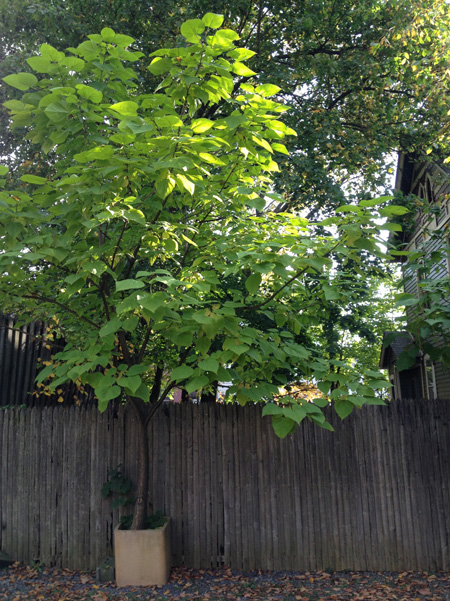
Catalpa
There must be an interesting backstory as to how this catalpa tree came to grow in this container—tree-to-container proportions not recommended …
When they’re set off in some way, such as marking both sides of a passageway, potted trees and shrubs give us a sense of order and rightness. You can do this with a pot of pansies or impatiens, but the effect isn’t quite as soaring.
Besides marking entrances, there are other reasons to use woody plants in pots. There is the sensual pleasure of having woody plants nearby, the focal points they create, the portability, and the deer thwarting. In pots close to your house, deer-vulnerable shrubs like arborvitaes enjoy a safe(r) haven.
You can also festoon potted trees near the house with holiday lights. One client kept three trouble-free junipers (Juniperus chinensis ‘Hetzi Columnaris’) for holiday lights in pots on the porch for five years before transplanting them out into the landscape, where they now make a beautiful buffer between neighbors. In highly urban situations where there is often a sea of concrete, a potted tree or a planter with multiple woodies bring welcome islands of green.
There are functional challenges pots can rise to. One client had a deck beyond which was a hillside of tangled ground cover that neither of us had the hubris to try to clear. Instead, we brought trees and shrubs into her living space on the deck. She wanted to have the feeling of a multi-layered garden (trees, shrubs, perennials, and annuals), but with a clustered collection of pots. We thought the woody plants in the deck garden should return each year for a good many years to justify their expense.
The trees and shrubs we picked for her had to be tough characters, because they might not get watered enough by this busy lady. So they had to be species that are tolerant of dry conditions. The woody specimens also had to be sufficiently cold hardy to overwinter in their pots outdoors. We didn’t want to have to move these heavy pots indoors every fall, nor did we want to be bothered with wrapping things up in ugly burlap. We tried out everything from hydrangeas to elderberries, with a high rate of success. Our first limiting criteria: winter hardiness.
Cold Considerations
You can see your USDA Hardiness Zone at planthardiness.ars.usda.gov. I live in Zone 6a, which means that the average extreme minimum low in the winter is -10 to -5 F. A woody plant’s stems are just as hardy in a pot as in the ground, but a plant’s root systems are significantly less cold hardy than its above-ground parts. When you plant in pots, or any planter that rises above the ground, the roots are exposed to colder ambient temps. In the earth, roots enjoy the temperature moderation provided by soil.
A rough guideline is that your plant selections for pots or elevated planters need to be hardy to at least two zones colder than your USDA zone. So in my case (zone 6a), in general, I’d want to use woody plants that are hardy to at least Zone 4a for any pots that I want to overwinter outdoors.
Here are some evergreen and deciduous woodies that have worked well for me in overwintered pots. They are all hardy to at least Zone 4a. It’s helpful to buy trees that have been propagated and grown in your region, by the way, because their local provenance ensures that they are adapted to your winters.
Evergreen
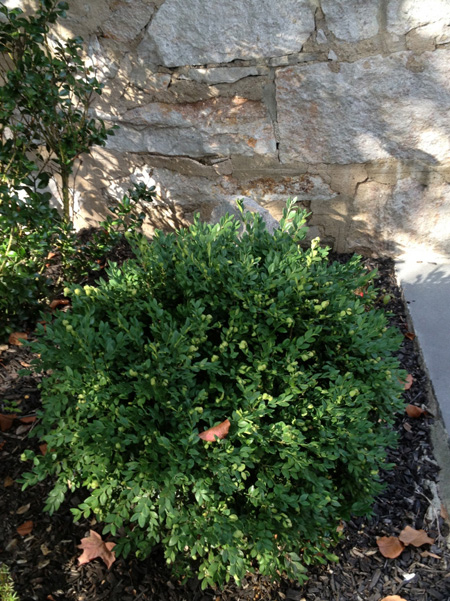
Boxwood
Boxwood for containers can be risky in terms of winter hardiness, but you might give it a go if you have a protected spot and a notably hardy variety.
Boxwood (like Buxus ‘Wintergreen’, which some sources cite as hardy to zone 4, others to zone 5 only), arborvitae (like Thuja occidentalis ‘Little Giant’), junipers (Juniperus sp.), and spruces (Picea sp).
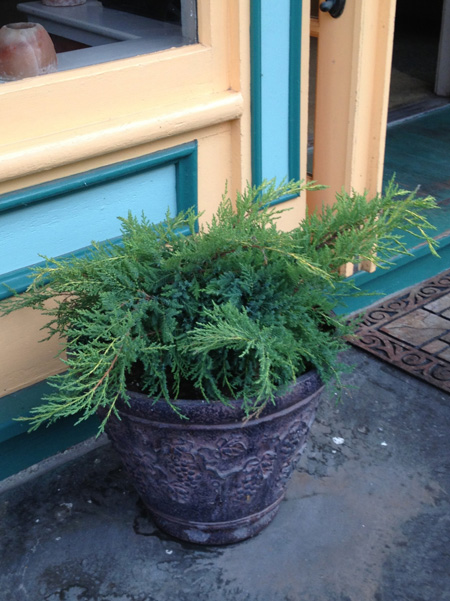
Juniper
Junipers are among the hardiest of the evergreens and coveted for their drought tolerance as well.
Deciduous
Dwarf rugosa roses (Rosa rugosa)
Elms (dwarf) (Ulmus sp.)
Baldcypress (dwarf) (like Taxodium distichum ‘Peve Minaret’)
Elderberry (like Sambucus ‘Black Lace’)
Ninebarks (like Physocarpus ‘Summer Wine’)
Black locust (like Robinia ‘Twisty Baby’ with awesome contorted branches)
Hydrangea paniculata (like ‘Limelight’)
Lilacs (not all, but many—check the label for hardiness zone)
Upright buckthorn (Rhamnus frangula ‘Fine Line’)
Here are some woodies I’m looking forward to trying in overwintered pots:
‘Northlight’ dwarf dawn redwood (Metasequoia glyptostroboides)
‘Robusta Green’ juniper
Dwarf ginkgo (Ginkgo biloba ‘Troll’)
Purple beautyberry (Callicarpa dichotoma) (hardy to 5a)
Knockout roses (zone 5)
‘Golden Spirit’ smokebush (Cotinus coggygria)
You may have areas around your home that are microclimates where you can get away with using potted plants a half or whole zone less hardy—in my case, plants with hardiness only to Zone 5a or 5b. Like all facets of horticulture, testing winter hardiness limits can be regarded as an experiment and an adventure!
Mixed Media
Cornell Urban Horticulture Professor Nina Bassuk says we should choose soil-less potting mix over “topsoil” or field soil of any kind. (She points out that simply calling something “topsoil” is a meaningless designation, by the way—anyone can call their product that, even if it’s junk.) Soil-less media like those using peat or coir (ground coconut hulls) are highly porous and designed to allow water to drain freely out of pots, while field soil in containers perches—i.e., hangs on to water too tightly.
A good mix will feel light and friable in the bag. Don’t be surprised that it’s actually a bit hydro-phobic at first: it takes a certain amount of water saturation to penetrate all that pore space. Once your trees and shrubs are potted up, water them deeply once or twice a week during the growing season. Less frequent but deeper watering is more effective than frequent shallow watering. Smaller pots will need to be watered more often than larger ones.
Bassuk says that the pots should be watered well before going into the winter. For one thing, well-hydrated woody plants are less prone to desiccation by winter winds. At the beginning of winter, she recommends moving the pots as close to the house as possible and ganging them together so the sides are touching. “The warmth of each pot insulates its neighbor,” she says. “You could also stack straw bales around them to further insulate them.”
The best containers for overwintering are salt-glazed pottery and plastic. Ceramic, lightweight foam, and terra cotta pots are the most likely to crack under the freeze-and-thaw pressure of our winters.
Time to Move Out
If a tree or shrub is well cared for in its container, it may outgrow its space. This will take a long time in the case of dwarf woodies. (By the way, “dwarf” means grows very slowly, but doesn’t necessarily stay small—for plants that stay little, see the “miniatures.”) You can prune the stems of shrubs and multi-stem trees to keep top growth in check, but this is not advisable for trees with one central leader.
For smaller potted plants whose roots have fully colonized the pot and clearly want to break out, you can transplant them into larger pots. More brutally, you can prune an outer rung of roots and then replant in the same pot, but this kind of root reduction is stressful on the plant.
For vigorously growing woodies, I transplant into successively larger pots and then at some point make the decision to move them into the landscape. Often this is after many years of service as a containerized woody element of a mobile, elevated, and elegant pot garden.
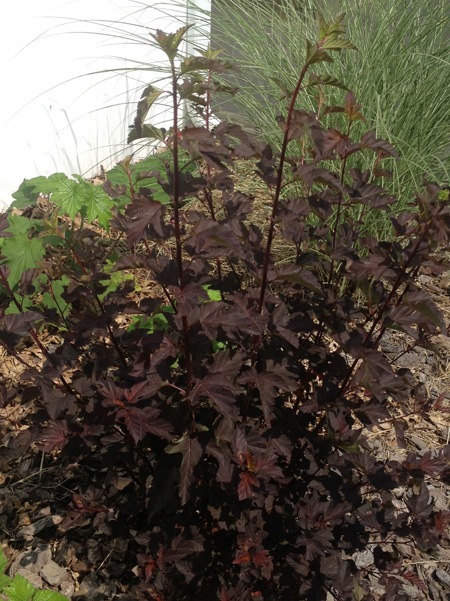
Summer Wine ninebark
Ninebarks (like ‘Summer Wine’, hardy to zone 3) can make good shrubs for containers and planters.
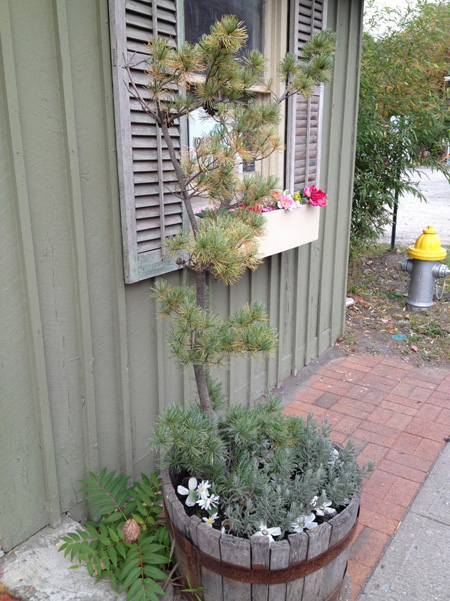 Pine tree
Pine tree
Just as in the larger landscape, a containerized pine can be expected to shed some needles in the fall.

Dwarf Alberta spruce
While dwarf Alberta spruces have some liabilities, they are very hardy for containers.
Views: 14





